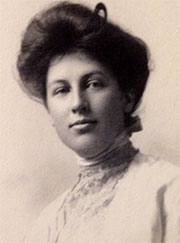From the 1st first to the 31st of March we, as a nation, celebrate women’s history. As stated by National Women’s History Project, March was proclaimed Women’s History Month since there was an absence of female history in the grade school system. By time of the mid-1970’s, Sonoma County, California was the first in the nation to proclaim that the week of March 8th was to be acknowledged as “Women’s History Week” in 1978. President Carter professed the week of the 8th to be “National Women’s History Week” soon following the California trend in 1980. Seven years later, in 1987, Congress announced March to be “National Women’s Month,” celebrating the successes of American women. So in light of the 1987 affirmation, I would like to commence in my own acknowledgment of the immense “bad-assery” of women in architecture and engineering. Although there are numerous infamous females in these fields, I would like to bring attention to three women that, I feel, pioneered a change for both architecture and engineering in the past two centuries.

Image Credit: ASME
Kate Gleason
According to ASME, Catherine Anselm Gleason was the first woman to enroll into the Mechanical Arts major at Cornell University at the age of nineteen. Gleason was born on November 25,1865 in Rochester, New York. She got interested into mechanics due to her father who was a machine shop owner. Although her interest was always present, they were never really conditioned until her older brother, unfortunately, died due to typhoid disease. She then took on his role, helping her father in the shop and learning the trade. Once she became of age, she attended Cornell University and was later the first woman to become a member of the American Society of Mechanical Engineering (aka ASME) after graduating in 1888. She went on to globalize her father’s business, making it the successful Gleason Corporation that is still used today.

Image Credit: Cornell University
Nora Stanton Blatch Barney
Based on an article by Cornell University, Nora Stanton Blatch Barney was the first woman to graduate in the Civil Engineering program in 1905. She was born in Basingstoke, Hampshire, England on September 30, 1883. As the age of fourteen, she began to study mathematics and Latin at the Horace Mann School in New York and spent her summers at home in England. The Blatch family moved to the United States in 1902 and Nora soon began the Civil Engineering program at Cornell University. She graduated in 1905 and went on to build bridges, subway tunnels, and water supply systems in New York. Apart from being a Civil Engineer, she was also an architect, real-estate developer, suffragist, social activist for female equality rights, and even an author.

Image Credit: Austin M. Fox
Louise Blanchard Bethune
As reported by Buffalo Architecture and History, Louise Blanchard Bethune was the first female architect in New York and to be inducted into the American Institute of Architects (aka AIA). Bethune was born on July 21, 1856 in Waterloo, New York. She was tutored at home until the age of eleven by her father who was a principal and teacher of mathematics at Waterloo Union School. After that age she was placed into school and later graduated in 1874. For the next few years, she spent time grooming herself to be prepared for the architectural program a Cornell University. Instead of attending the program, she radically turned down the opportunity and took an apprenticeship as a draftsman (or draftswoman per se) with a highly acclaimed architectural firm in Buffalo owned by Richard A. Waite and F.W. Caulkins. From 1876 to 1881, she honed the trade of architectural drafting and design. In October of 1881, She opened an an architectural office, in which, she co-owned with soon-to-be husband, Robert Armour Bethune.



